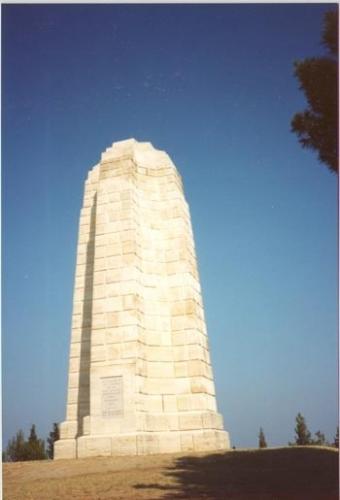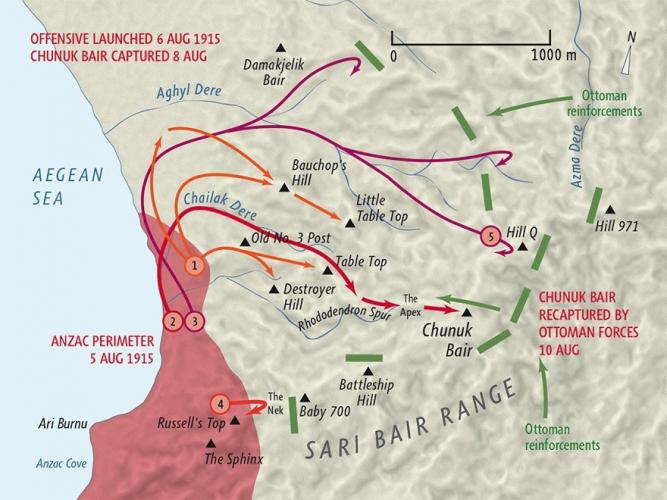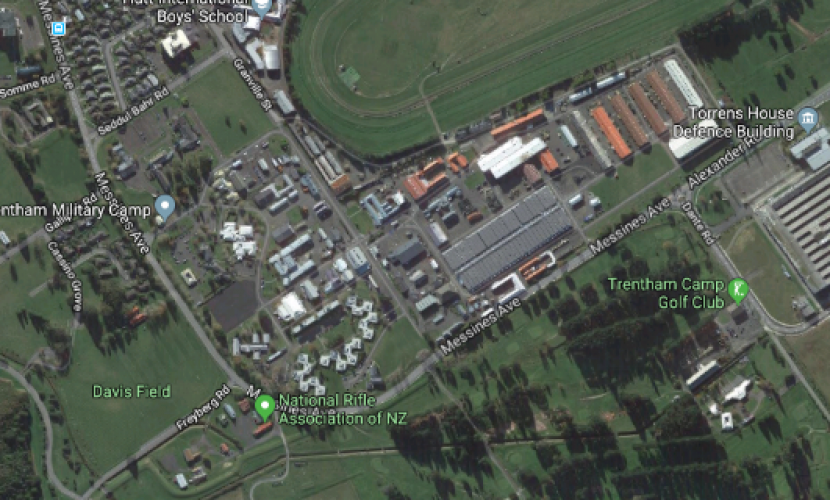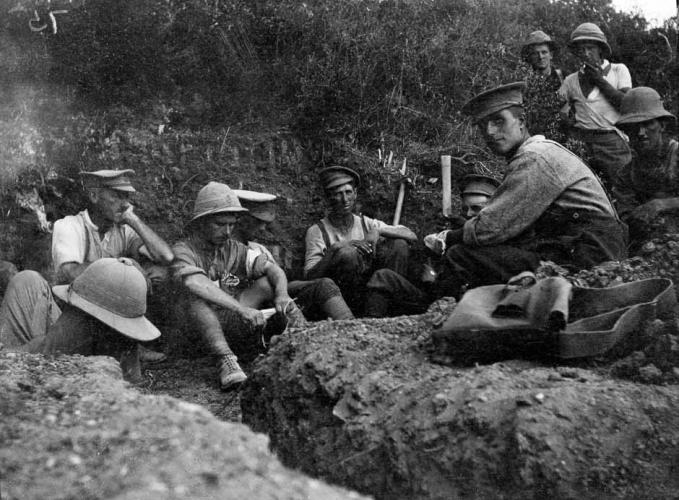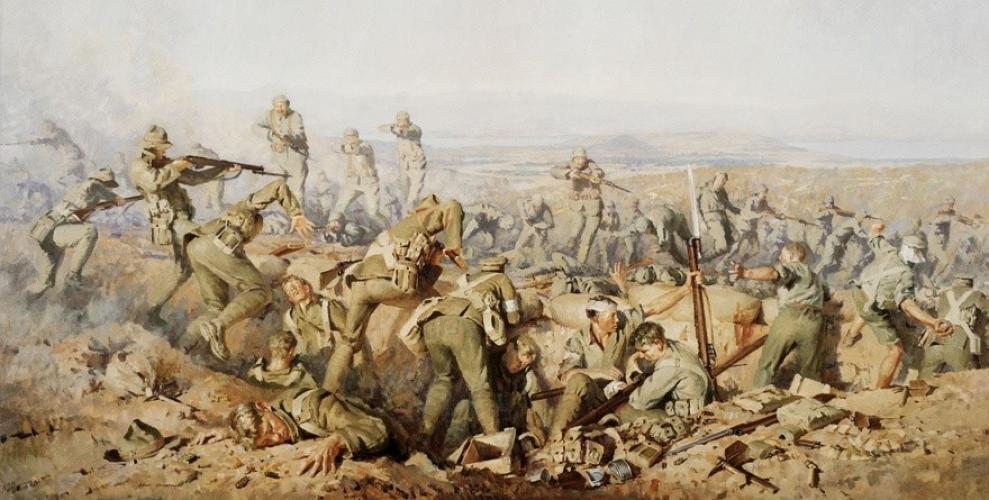287 Sairi Bahr Rd, TMC Upper Hutt, road sign 2018
Reason for the name
This street was named after a battle of the Gallipoli campaign also known as the Sari Bair offensive. Most streets within NZDF Camps and Bases are named in honour of prominent people, battles, campaigns, ships, aircraft and places creating a rich history of our military service. Trentham Camp’s streets have been changed as the Camp has been redeveloped throughout the years.
The Sari Bair offensive. As the futile attacks continued at Helles, the Allies began looking at alternative strategies to break the deadlock. Lieutenant-General Birdwood, the ANZAC commander, formulated a plan to break through the Ottoman lines at Anzac and seize the heights of the Sari Bair range. Lieutenant-General Hamilton had given up on breaking out at Helles and seized upon Birdwood’s idea. He expanded the plan to include landing two British divisions at Suvla Bay, 8 km north of Anzac Cove, and launching diversionary attacks at Cape Helles.
At Anzac Cove, the task of carrying out the assault on Sari Bair fell to the New Zealand and Australian Division, the newly arrived British 13th (Western) Division, 29th Indian Brigade, and part of the 10th (Irish) Division. Major-General Godley assumed overall command of this force.
Author: The Poppy Places Trust
The success of Hamilton’s plan rested on timing and speed. While the Australians made a diversionary assault to distract Ottoman attention, two columns of men would advance up the Sari Bair range and capture the three key high points of Chunuk Bair, Hill Q and Hill 971 (Koja Chemen Tepe) during the night of 6-7 August. At dawn, a joint assault on the Nek from New Zealand and Australian forces on Chunuk Bair and Russell’s Top would complete the capture of the whole ridge as far as Hill 971.
Meanwhile, British troops would land in Suvla Bay, north of Anzac, and move forward to support the assault on the range.
Initial attacks: 6-7 August
The August offensive opened on 6 August with an Australian attack on Lone Pine, at the southern end of the Anzac perimeter, and diversionary British and French attacks at Helles. While Helles was a costly failure, Lone Pine proved more successful. Four days of savage fighting secured the area for the Australians at the cost of more than 2000 casualties. While the attack sucked in some Ottoman reserves, this proved counterproductive, for they redeployed on the Sari Bair range.
Godley’s attack began after dusk that night. As soon as it was dark, two covering forces moved out to capture the foothills over which two assault columns would move to seize Chunuk Bair, Hill Q and Hill 971. Everything went to plan initially. On the right, New Zealand Mounted Rifles units and the Native Contingent captured four of the five key features assigned to them – Old No. 3 Post, Big Table Top, Destroyer Hill and Little Table Top. The fifth (Bauchop’s Hill) proved tougher to crack, with the Otago Mounted Rifles suffering some 100 casualties in taking it, and losing their commanding officer, Lieutenant-Colonel Arthur Bauchop.
By the time the Mounted Rifles secured their objectives, the attack was several hours behind schedule. From that point on, the plan began to fall apart. The left assaulting column, made up of British and Indian troops, got lost in the darkness and rugged terrain. The right assaulting column never formed. Its two elements — the New Zealand Infantry Brigade and an Indian mountain battery — did not make their intended rendezvous on Rhododendron Spur, below the summit of Chunuk Bair. At dawn on 7 August, the New Zealand Infantry Brigade’s commander, Brigadier Francis Johnston, was still waiting on the Spur for missing units to arrive. It was daylight before the troops were ready to move; by then the Ottomans had reinforced Chunuk Bair.
Across the valley, Birdwood decided to press ahead with the planned dawn attack at the Nek even though the New Zealanders were in no position to launch a converging attack from Chunuk Bair. He thought that an assault might distract the enemy and help the assaulting columns take Chunuk Bair. Successive waves of Australian light horsemen were cut down charging the Ottoman trenches. By the end of the attack, more than 200 Australians lay dead or dying in no-man’s-land.
Despite the carnage at the Nek, Godley insisted that Johnston press on, and at 10.30 a.m., the Auckland Battalion attacked Chunuk Bair. They got as far as an old Ottoman trench at the Pinnacle before heavy machine-gun and rifle fire forced them to take cover. When Johnston ordered the Wellington Battalion forward, its commander, Lieutenant-Colonel William Malone, refused to attack during daylight, insisting he would not send his men ‘over to commit suicide’. Godley eventually agreed to postpone the attack until nightfall.
Battle for Chunuk Bair: 8-10 August
Malone’s Wellington Battalion advanced up onto Chunuk Bair in the early hours of 8 August. They found it unoccupied – the defenders had surprisingly pulled out during the night. It was not long before the Ottomans realised their mistake and sent troops to retake the position. For the next 24 hours, the Wellington Battalion, reinforced by the Auckland Mounted Rifles and two British battalions, held the summit against repeated attacks.
Casualties amongst the defenders were extremely high. The New Zealanders on Chunuk Bair were completely isolated from the rest of the Allied line and subjected to intense artillery, machine-gun and rifle fire from nearby Hill Q and Battleship Hill. There were also instances of ‘friendly fire’ from artillery and naval gunfire laid around the summit to break up the Ottoman infantry assaults – Malone was killed in one such incident on the evening of 8 August.


